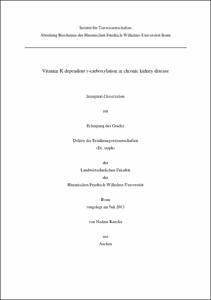Vitamin K dependent γ-carboxylation in chronic kidney disease

Vitamin K dependent γ-carboxylation in chronic kidney disease

| dc.contributor.advisor | Schmitz, Brigitte | |
| dc.contributor.author | Kaesler, Nadine | |
| dc.date.accessioned | 2020-04-19T07:48:30Z | |
| dc.date.available | 2020-04-19T07:48:30Z | |
| dc.date.issued | 10.01.2014 | |
| dc.identifier.uri | https://hdl.handle.net/20.500.11811/5820 | |
| dc.description.abstract | Vascular calcification is present in atherosclerosis, ageing, chronic kidney diseases and diabetes and is strongly associated with an increased morbidity and mortality. Calcification of arteries occurs at the tunica intima and the tunica media. Thereby, vascular smooth muscles cells (VSMC) transdifferentiate into an osteoblastic phenotype. Modifiable calcification inhibitors were identified of which matrix gla protein (MGP) is regarded as the most potent one being expressed in the vascular wall. MGP gets posttranslationally gamma carboxylated at 5 glutamic acid residues, which achieve calcium binding properties. This carboxylation step requires reduced vitamin K as a cofactor. It is provided and recycled in the so called vitamin K cycle, which consists of the vitamin K epoxide reductase (VKOR), DT-diaphorase and γ-glutamyl carboxylase (GGCX). The effects of uremia on vitamin K recycling via the vitamin K cycle are unknown. Besides MGP, other vitamin K dependent proteins are known. One is the Gas6 protein, which is also expressed by VSMC, but its role is not yet fully understood. Gas6 offers one n-terminal carboxylation site. Aim of this thesis was to characterize the activities of three enzymes of the vitamin K cycle and the role of vitamin K dependent Gas6 protein under uremic conditions. First, a fluorescence method for the quantification of GGCX activity in vitro in tissue samples was developed. This method employs a fluorescein isothiocyanate (FITC) labelled Glu containing hexapeptide which gets carboxylated by the GGCX. Second, the influences of uremia and pharmacological doses of vitamin K supplementation on the activity of the vitamin K cycle and extraosseous calcification were investigated. Uremia was induced in rats by adenine diet, in part supplemented with vitamin K1 or K2 for 4 or 7 weeks. The GGCX activity was decreased under uremic conditions possibly contributing to calcifications. The GGCX activity can be restored by vitamin K supplementation. Third, the influence of Gas6 protein on vascular calcification was investigated in murine in vitro VSMC culture and different in vivo models using a) Warfarin diet, b) uninephrectomy or c) electrocautery of the kidney as well d) ageing mice. No differences were found in tissue calcium content, echocardiography and biochemical serum and urine parameter between Gas6-/- mice and wildtype controls. This does not support a role of Gas6 in the pathogenesis of vascular calcification. | en |
| dc.description.abstract | Vitamin K abhängige Gamma-Carboxylierung in der chronischen NIereninsuffizienz Vaskuläre Kalzifizierung tritt als eine Begleiterscheinung von Atherosklerose, Alter, chronischen Nierenerkrankungen und Diabetes auf und geht mit einer stark erhöhten Morbidität und Mortalität einher. Arterielle Kalzifizierungen erfolgen in der Tunica intima und der Tunica media. Hier transdifferenzieren glatte Gefäßmuskelzellen (vascular smooth muscle cells, VSMC) in einen osteoblastären Phänotyp. Regulierbare Verkalkungsinhibitoren sind bekannt, wie das Matrix Gla Protein (MGP), welches insbesondere in der Gefäßwand von VSMC exprimiert wird. MGP wird an 5 Glutamatresten posttranslational γ-carboxyliert, wodurch eine Kalziumbindung ermöglicht wird. Zur γ-Carboxylierung wird reduziertes Vitamin K als Cofaktor benötigt. Dieses wird im sogenannten Vitamin K Zyklus bereitgestellt und recycelt. Die beteiligten Enzyme sind die Vitamin K Epoxid-Reduktase (VKOR), DT-Diaphorase und γ-glutamyl-Carboxylase (GGCX). Der Einfluss einer Urämie auf das Vitamin K Recycling im Vitamin K Zyklus ist unbekannt. Neben MGP sind weitere Vitamin K abhängige Proteine bekannt. Hierzu zählt auch das Gas6 Protein, welches ebenfalls von VSMC exprimiert wird, aber dessen Funktion noch nicht vollständig geklärt ist. Das Ziel dieser Arbeit war die Charakterisierung der Enzymaktivitäten im Vitamin K Zyklus und die Rolle des Vitamin K abhängigen Gas6 Proteins in der experimentellen Urämie. Dazu wurde zunächst eine Fluoreszenz-gestützte Methode entwickelt, zur Bestimmung der GGCX Aktivität in Gewebeproben. Verwendet wurde ein Fluorescein Isothiocanat (FITC) gekoppeltes Glu-haltiges Hexapeptid, welches durch die GGCX carboxyliert wird. Zweitens wurde der Einfluss einer Urämie sowie die Verabreichung pharmakologischer Dosen Vitamin K auf die Enzyme des Vitamin K Zyklus und extraossäre Kalzifikation untersucht. Durch Gabe von Adenin über einen Zeitraum von 4 oder 7 Wochen wurde in Ratten eine Urämie induziert, teilweise unter Supplementation mit Vitamin K1 oder K2. Die GGCX-Aktivität war unter urämischen Bedingungen erniedrigt, wodurch möglicherweise Kalzifizierungen getriggert werden. Die erniedrigte GGCX-Aktivität kann durch zusätzliche Vitamin K Gabe aufgehoben werden. Drittens wurde der Einfluss des Gas6 Proteins auf die Gefäßkalzifikation in murinen in vitro VSMC Kultur und in verschiedenen in vivo Modellen untersucht: a) Warfarin Diät b) Uninephrektomie c) Elektrokoagulation der Niere sowie d) alternde Mäuse. Keine Unterschiede wurden festgestellt im Calciumgehalt des Gewebes, echokardiographisch und in den gemessenen Serum- und Urin-Parameteren. Diese Daten unterstützen keine Rolle von Gas6 in der Pathogenese der vaskulären Kalzifikation. | en |
| dc.language.iso | eng | |
| dc.rights | In Copyright | |
| dc.rights.uri | http://rightsstatements.org/vocab/InC/1.0/ | |
| dc.subject | Vitamin K | |
| dc.subject | Calcification | |
| dc.subject | Nephrology | |
| dc.subject.ddc | 500 Naturwissenschaften | |
| dc.subject.ddc | 570 Biowissenschaften, Biologie | |
| dc.subject.ddc | 610 Medizin, Gesundheit | |
| dc.subject.ddc | 630 Landwirtschaft, Veterinärmedizin | |
| dc.title | Vitamin K dependent γ-carboxylation in chronic kidney disease | |
| dc.type | Dissertation oder Habilitation | |
| dc.publisher.name | Universitäts- und Landesbibliothek Bonn | |
| dc.publisher.location | Bonn | |
| dc.rights.accessRights | openAccess | |
| dc.identifier.urn | https://nbn-resolving.org/urn:nbn:de:hbz:5n-34683 | |
| ulbbn.pubtype | Erstveröffentlichung | |
| ulbbnediss.affiliation.name | Rheinische Friedrich-Wilhelms-Universität Bonn | |
| ulbbnediss.affiliation.location | Bonn | |
| ulbbnediss.thesis.level | Dissertation | |
| ulbbnediss.dissID | 3468 | |
| ulbbnediss.date.accepted | 19.11.2013 | |
| ulbbnediss.fakultaet | Landwirtschaftliche Fakultät | |
| dc.contributor.coReferee | Diestel, Simone |
Dateien zu dieser Ressource
Das Dokument erscheint in:
-
E-Dissertationen (1108)




